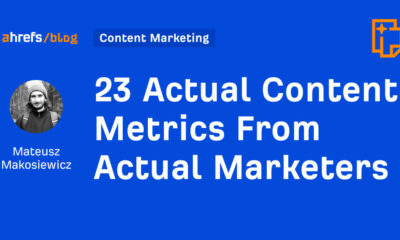Measurement is a challenge to every aspect of marketing from attribution to campaign optimization. To meet that challenge, marketers need insights into the vast quantities of data being generated from the wealth of customer touchpoints. New technologies surface insights faster and create the opportunity to visualize and share data. Tools are even giving marketers the ability to predict interactions in order to increase efficiency and allow for real-time adjustments.
Data and analytics take the guesswork out of marketing. They help you get more value from your marketing budget (e.g., better efficiency), improve customer experience, and understand what channels, touchpoints, and strategies are working.
Marketing analytics is an approach to data analysis that helps businesses understand the performance and impact of their marketing investments. Businesses use marketing analytics tools to facilitate the collection, modeling, analysis, and visualization of marketing data.
New technologies are making old channels more accessible. For example, more digital marketers are expanding their campaigns to offline spaces thanks to technologies like programmatic digital out-of-home (DOOH), which enables them to reach hyperlocal audiences on the street and at public venues.
This expanding digital ecosystem, combined with the proliferation of consumer and marketing data and the impending loss of third-party cookies, requires that marketers have a proactive marketing analytics strategy.
In this post, we’ll cover the basics of marketing analytics — what it is, why it’s important, and how marketing teams can use it effectively. Key points covered include:
Estimated reading time: 8 minutes
What is marketing analytics?
Marketing analytics is an umbrella term used to describe the processes and technology involved in measuring a company’s marketing activities. Data is central to marketing analytics. Marketing data includes (but is not limited to) the following:
- Website analytics: Website visits, traffic patterns, referral sources, bounce rate, etc.
- Social media interactions: Social engagements, follows, profile views, shares, and DMs.
- Online purchases and transactions: Leads, signups, and sales.
- Paid ad campaign metrics: Ad views, clicks, CTR, CPM, CPC, conversions, conversion rate, CPL, and overall performance.
- Customer data: Feedback, behavior, and purchase history.
The people involved in measuring a company’s marketing activities use technology and software that gathers marketing data, aggregates it, and provides visualizations to help them understand what tactics are working and how best to optimize marketing spend.
Types of marketing analytics models
There are three marketing analytics models that marketers use when planning, managing, and optimizing marketing campaigns. The goal of all three models is to help marketers make more insightful decisions about how to plan their campaigns and allocate their budgets.
- Descriptive: Descriptive models use historical data culled from prior campaign activity to understand what happened and, based on this, inform future campaign planning. This is the “hindsight is 20/20” model, which looks at what happened with past campaigns and uses this information to inform future strategies.
- Predictive: These models go a step further than descriptive, taking insights and using insights from past campaigns to try and predict customer behavior. This approach seeks to predict influence customer behavior to create a more informed (and targeted) marketing campaign.
- Prescriptive: Prescriptive models use data from all touchpoints, weighing the impact of each interaction and initiative, for the purpose of creating a campaign that influences customer behavior and/or is more efficient. Prescriptive campaigns are highly targeted and often hyperlocal or focused on a current trend.

Why should you care about marketing analytics?
Marketing analytics can surface insights that you weren’t aware of, like how offline and online channels work together and how each consumer interaction influences the final sale or lead or signup (e.g., marketing attribution).
Here are some more reasons you should care about marketing analytics:
- It provides tangible data around paid marketing initiatives — CPC, CPL, ROI, and brand lift.
- It informs how your marketing campaigns and initiatives are performing, often in real-time, so you can optimize for improvement.
- It connects your marketing campaigns to your website traffic and other metrics, enabling you to understand how various tactics and channels impact user and customer behavior.
- It surfaces opportunities that influence future marketing and content strategies (e.g., a paid search campaign can inform your organic SEO content strategy).
- It helps you do more with your advertising dollars and increase efficiency by reallocating spend to the most effective channels.
- It provides a trove of data and information on customers and prospects which can be used to inform customer journey mapping and test the viability of new markets, products, and services.
- It validates marketing expenses by tying ROI to initiatives.

Explore capabilities from vendors like Adobe, Pointillist, SharpSpring, Salesforce and more in the full MarTech Intelligence Report on customer journey analytics platforms.
Who uses or works with marketing analytics tools?
Marketing analytics tools are generally the purview of marketing teams. Here are some use cases that highlight how marketing data is used.
Budget optimization. Your marketing budget has been cut by 10%, 15%, or 30% and you need to refocus your marketing strategy on the best-performing channels and tactics. By analyzing the performance against predetermined KPIs, you can reallocate your budget to the historically best-performing channels.
Media planning. Marketing analytics provides historical data which can be used to make better media planning decisions. You can use results from past campaigns to inform ad creative, media mix, and test new channels. Importantly, marketing analytics ensures that your media choices reflect your audiences’ preferences, and not just what your gut is telling you.
Content planning. Website traffic metrics, paid search campaign reports, keyword trends, and user behavior provide valuable information about what your customers are interested in. You can use this information to plan your content and messaging strategies, for example, by reviewing top content on your website, the most engaging social media posts, and using social media listening tools that surface insight and buzz around a given trend or product.
Create audiences and build customer personas. Marketing campaign data can help you better define and understand your customers so you can build more targeted audiences for future campaigns. Identifying customer content preferences can help you craft content that specific audiences are more likely to engage with. This also helps improve a customer’s experience with your brand.
Key goals of marketing analytics
Here are some of the main goals marketing analytics tools can help brands meet:
- Understanding what marketing channels, tactics, and approaches work best to achieve a business goal (e.g., growth, sales, leads, etc.).
- Measuring ROI from marketing and advertising initiatives.
- Capturing data from website sessions to better understand what content customers value.
- Observing how users interact with website features and objects like buttons, video, and forms.
- Monitoring, managing, and optimizing performance for digital and offline marketing campaigns.
- Creating audience segments for more precise ad and content targeting and personalization.
- Providing clear data visualizations to better analyze and act on data for a variety of audiences, including executive/board level as well as tactical reporting.
- Enabling different teams and departments to share campaign performance and collaborate on marketing strategy.
- Understanding how content, marketing, sales, customer behavior, and all marketing and sales initiatives are working together (e.g., customer journey analytics).
The variety of touchpoints connected to the modern customer journey are transforming the way marketers track their campaigns. Where once data analysis was focused on browser and website activity, now consumers are combining online and offline channels to learn about companies, brands, and products.
A recent Google poll revealed that over 70% of people described themselves as channel-agnostic, meaning they were more flexible about whether they buy offline or online. Analytics tools can help marketers keep track of this growing subset of customers.
There are a variety of ways that marketers get the data they need to, plan, analyze and optimize campaigns and no shortage of tools available to help get the job done. Some of these tools can also collect data from offline channels and integrate it with digital campaign data. They include:
- Website analytics tools like Google Analytics, Adobe Analytics, and MixPanel.
- Campaign analytics tools like Semrush, Cyfe, and Klipfolio.
- Social analytics tools like SproutSocial and HootSuite.
- Social listening tools like Brandwatch and Falcon.io.
- Customer journey analytics (CJA) software like Sprinklr, Thunderhead, and Pointillist.
- Sales intelligence tools like HubSpot, Salesforce, and ActiveCampaign.
- Marketing data aggregators like Domo and Supermetrics.
- Company financial data.
Many of the above-listed tools have features that intersect with each other. Google Analytics has robust website traffic analytics, campaign analytics, and some journey mapping capabilities.
SproutSocial provides social media engagement analytics and social listening to help users surface trends and insights from social data.
It’s standard operating procedure for marketers to use more than one tool or platform. Thus, it’s becoming increasingly important to connect and integrate your marketing data sources into one (and please forgive us for this buzzword) “single source of truth,” which lets you understand your entire marketing ecosystem. Tools like Domo and Supermetrics integrate data from multiple sources, where it can be used to create marketing reports and dashboards.

Know how your customers interact with your advertising today and into the future. Explore the platforms essential to predictive analytics and marketing attribution in the latest edition of this MarTech Intelligence Report.
How marketing analytics can help marketers succeed
As customer journeys shift and new touchpoints and channels emerge, showing how ad campaigns and marketing initiatives work together to achieve a goal will become more important. The marketing ecosystem is also becoming more digital, with digital marketing comprising nearly 60% of marketing budgets according to the AMA’s 2021 CMO Survey.
Marketing analytics can help CMOs demonstrate the effectiveness of their campaigns. It’s the best way to illustrate the tangible impact that marketing has on business success. And as marketing budgets become fragmented across more channels, tools, and initiatives, marketing analytics can help ensure there’s adequate funding for the next quarter’s ad and marketing campaign spending.
Resources for learning more about marketing analytics
Do you want to learn more about marketing analytics? We recommend the following resources:
Marketing attribution and predictive analytics: A snapshot
What it is. Marketing attribution and predictive analytics platforms are software that employ sophisticated statistical modeling and machine learning to evaluate the impact of each marketing touch a buyer encounters along a purchase journey across all channels, with the goal of helping marketers allocate future spending. Platforms with predictive analytics capabilities also use data, statistical algorithms and machine learning to predict future outcomes based on historical data and scenario building.
Why it’s hot today. Many marketers know roughly half their media spend is wasted, but few are aware of which half that is. And with tight budgets due to the economic uncertainty brought about by the COVID-19 pandemic, companies are seeking to rid themselves of waste.
Attribution challenges. Buyers are using more channels and devices in their purchase journeys than ever before. The lack of attributive modeling and analytics makes it even more difficult to help them along the way.
Marketers continuing to use traditional channels find this challenge magnified. The advent of digital privacy regulations has also led to the disappearance of third-party cookies, one of marketers’ most useful data sources.
Marketing attribution and predictive analytics platforms can help marketers tackle these challenges. They give professionals more information about their buyers and help them get a better handle on the issue of budget waste.
Read Next: What do marketing attribution and predictive analytics tools do?







![What’s Media Mix Modeling? [Marketer’s Guide with Examples] What’s Media Mix Modeling? [Marketer’s Guide with Examples]](https://articles.entireweb.com/wp-content/uploads/2024/03/Whats-Media-Mix-Modeling-Marketers-Guide-with-Examples-400x240.jpg)
![What’s Media Mix Modeling? [Marketer’s Guide with Examples] What’s Media Mix Modeling? [Marketer’s Guide with Examples]](https://articles.entireweb.com/wp-content/uploads/2024/03/Whats-Media-Mix-Modeling-Marketers-Guide-with-Examples-80x80.jpg)


























You must be logged in to post a comment Login